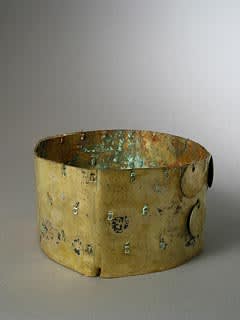Mochica Tumbaga Crown, 1 CE - 600 CE
Tumbaga
9.5 x 4.125
FZ.235
Further images
The Moche people of ancient Peru have often been called the Greeks of South America, and with good reason. The rudimentary technical and artistic developments of earlier cultural styles achieved...
The Moche people of ancient Peru have often been called the Greeks of South America, and with good reason. The rudimentary technical and artistic developments of earlier cultural styles achieved an astonishing maturity in the Mochica art style. The specialization of craftsmanship which began during the Chavin culture was developed further during this classic period, resulting in the evolution of an immense variety of special skills, the discoveries of the past forming the basis on which new techniques could unfold. This artistic creativity and craftsmanship is dramatically illustrated in this gilt copper diadem, its relatively simple form instilled with a spirit of elegant beauty. The diadem is formed from a wide circular band, joined at the back and pierced throughout for attachment with three rows of gilt copper medallions, each of flattened circular shape some of which are missing. In antiquity, the diadem would have been part of a larger headdress incorporating a turban and decorative feather work as well. We can just imagine the powerful image created when an important member of Moche society adorned himself with this regal attire. How fortunate we are that a vestige of this brilliant culture remains today, able at an instant to captivate our imagination and thrill our senses.







